Léon Monet, frère de l’artiste et collectionneur (Léon Monet: The Artist’s Brother and Collector)
Reviewed by Simon KellySimon Kelly
Curator of Modern and Contemporary Art
Saint Louis Art Museum
Email the author: simon.kelly[at]slam.org
Citation: Simon Kelly, exhibition review of Léon Monet, frère de l’artiste et collectionneur (Léon Monet: The Artist’s Brother and Collector), Nineteenth-Century Art Worldwide 22, no. 2 (Autumn 2023), https://doi.org/10.29411/ncaw.2023.22.2.18.
This work is licensed under a Creative Commons Attribution-NonCommercial 4.0 International License  unless otherwise noted.
unless otherwise noted.
Your browser will either open the file, download it to a folder, or display a dialog with options.
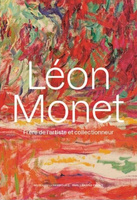
Léon Monet, frère de l’artiste et collectionneur
Musée du Luxembourg (Sénat), Paris
March 15–July 16, 2023
Catalogue:
Géraldine Lefebvre, ed.
Léon Monet, frère de l’artiste et collectionneur (Léon Monet: The Artist’s Brother and Collector).
Paris: Réunion des musées nationaux-Grand Palais, 2023.
256 pp.; 116 color and 76 b&w illus.; bibliography; notes; inventory; index.
€39 (hardcover)
ISBN: 978–2–7118–7965–6
Families matter. Or more precisely, in the case of this exhibition, siblings matter. The history of impressionism has several stories of close sibling relationships: Berthe and Edma Morisot, Gustave and Martial Caillebotte, Edgar and René Degas, Mary and Lydia Cassatt. Yet surprisingly little attention has been given to the narrative of Claude Monet’s relationship with his elder brother, Léon Monet, a chemist, industrialist, and collector, who was born in 1836 and was thus four years Claude’s senior. Léon has been little discussed in the standard histories of Monet’s work or of impressionism in general.[1] This exhibition argues that he has been unfairly overlooked and that he was in fact a pivotal figure in the network of patrons and supporters around his brother, and a central figure in securing Claude’s success.
Léon Monet, frère de l’artiste et collectionneur is curated by Géraldine Lefebvre, who is currently working on the catalogue raisonné of Monet’s pastels, and who published on Léon in an exhibition on the Rouen collector François Depeaux at the Musée des Beaux-Arts de Rouen in 2020.[2] This exhibition is the result of three more years of her research, and it provides much new information on Léon, often based on resources provided by family descendants. The exhibition brings together nearly 160 paintings, prints, and archival documents. Léon’s rehabilitation can be seen within the context of the growing interest in impressionist collecting, as evidenced by the recent essay compilation, Collectionner l’Impressionisme, edited by Ségolène Le Men and Félicie de Maupeou.[3] This is an area which is no doubt only going to grow, especially with the 2024 celebrations surrounding the 150th anniversary of the first impressionist exhibition.
The exhibition opens with a wall introducing the core themes of Monet as brother and collector against a detail of Monet’s late colorful and abstract Jardin de Giverny (The Garden at Giverny) (fig. 1).[4] The first section focuses on the history of the Monet family, evoking Léon’s early years in Le Havre, where the family moved from Paris in 1845. This section includes large-scale blow-ups of photographs of Léon and Claude as young men, highlighting their early physical resemblance (fig. 2). Among the paintings on view are Claude’s early portrait of his father, Adolphe; and Renoir’s portraits of Claude reading and of Claude’s wife, Camille Doncieux (fig. 3). There are also Claude’s pastels of his two sons, Jean and Michel, and his stepdaughter, Blanche. Perhaps the greatest coup of the exhibition is the rediscovery of Claude’s 1874 portrait of his brother, Léon, which has never been exhibited and remained hidden in the family collection (fig. 4). Monet produced few portraits, and this is the only portrait that he did of his brother. It is full of energy and vivacity, highlighting Monet’s often overlooked abilities as a portrait painter. Léon is represented in his late thirties, in bowler hat, jacket, and fob watch, and with his cheeks flushed. Painted in the year of the first impressionist exhibition, it is rapidly brushed. Léon’s raised eyebrow lends the picture a slightly caricatural effect, reminding us that Claude had produced lively caricatures in his youth.[5] Claude gave the portrait to his brother, but Léon did not like it for unknown reasons and never displayed it in his house in Maromme, outside of Rouen. Perhaps this dislike was because of the picture’s unfinished quality, as Lefebvre argues in the catalogue. The nature of the dynamic between the two men is often difficult to reconstruct. Surprisingly, no correspondence exists between them, a situation that we might contrast with the voluminous correspondence between Monet and his dealer, Durand-Ruel.
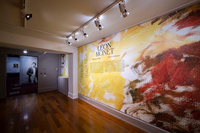
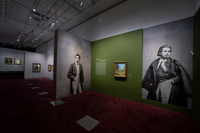
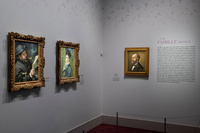
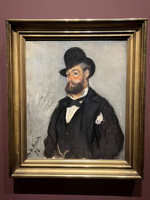
The next section focuses on Léon as a collector and is really the heart of the exhibition. It opens with a display of Léon’s photographic albums of the works in his collection, all carefully annotated by him and showcasing his interest in creating a kind of musée imaginaire (fig. 5). As the catalogue tells us, Léon owned sixty-seven works in total, including twenty paintings by his brother, Claude, three by Renoir, three by Pissarro, and one by Sisley. Six of the Monet paintings are in the exhibition: the portrait of Léon, two luminous early views of Sainte-Adresse and one of Étretat, a view of ships under repair at Le Havre (fig. 6), and Meditation. Madame Monet on the Sofa (1870–71; Musée d’Orsay), a view of Claude’s wife, Camille, which Léon acquired early on and exhibited at the 23rd Exposition municipale des Beaux Arts de Rouen in 1872. There is also an impressive and little-known Renoir Parisian view, Paris, L’Institut au quai Malaquais (1872), borrowed from a private collection, as well as Sisley’s scintillating Louveciennes snow scene (1874; Museum Barberini, Potsdam) (fig. 7).[6] The works of these canonical artists are complemented by lesser-known figures such as Blanche Hoschedé-Monet (fig. 8, an artist now attracting greater attention, it should be said) and painters from the School of Rouen like Marcel Delaunay and Georges Bradberry. It is worth noting, however, that, for whatever reason, some of the Monet highlights of Léon’s collection such as the large and early Spring Flowers (1864; Cleveland Museum of Art), Adolphe Monet Reading in a Garden (1867; private collection), the Marine View with a Sunset (1875; Philadelphia Museum of Art), and the Villas at Bordighera (1884; Museum Barberini, Potsdam), are not included in the exhibition.[7] Nor is Renoir’s well-known Lise, also known as In Summer (1868; Alte Nationalgalerie, Berlin). Such works would only have served to strengthen the exhibition’s argument regarding the importance of Léon as a collector. Fortunately, Lefebvre’s catalogue includes a very useful and exhaustive inventory of the paintings in Léon’s collection, which will provide a lasting record.
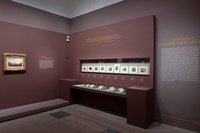
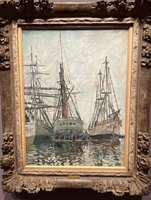
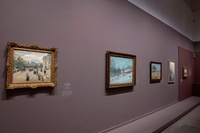
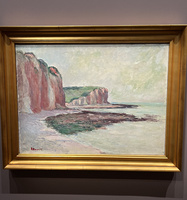
The next section focuses on Léon’s career as a color chemist (fig. 9). In 1869, Léon, after an early spell as a merchant, became the Rouen sales representative for the Swiss company Geigy and Co., which specialized in the production of synthetic aniline dyes. These dyes were used for textiles, several examples of which are in the exhibition (fig. 10). Thereafter, Léon was a founding member of the Société industrielle de Rouen (SIR), established in 1872, with the aim of promoting the significant Rouen cotton and textile industry. Most significantly, he ran the factory at the Rouen suburb of Maromme, which Geigy and Co. established in 1892 to circumvent customs duties between France and Switzerland. This position seems to have given him considerable opportunity to experiment with the production of new synthetic colors, and he developed his own color innovations in a laboratory which he called “the kitchen of colors.” The writer André Gide visited it and described it in his autobiography as “a small building, always closed, where the colors were secretly manufactured . . . [it] exhaled a strange smell.”[8] The exhibition includes samples of the Geigy company’s luminous synthetic colors, the intensity of which challenged natural dyes (fig. 11). In this section, full of archival photographs of the factory, we have a sense of Léon’s fascination with color and his near Faustian chemical experiments. Claude would have had direct knowledge of this factory since his son, Jean, worked there from the early 1890s until 1909. Claude indeed seems to have blamed Léon for Jean’s respiratory health problems, which may have been caused by the dangerous chemicals used in the factory. This was probably a significant factor in the cooling of the relationship between the two men. From around 1900, their meetings became rarer, leading to an eventual rift, and Claude did not attend his brother’s funeral in 1917.
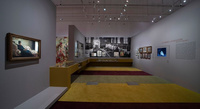
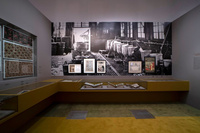
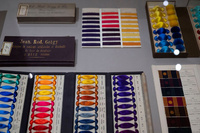
The next section examines Claude Monet’s visits to Rouen, which were largely inspired by the presence of his brother there (fig. 12). During a productive trip in 1872, he produced eleven paintings, including a view of ships on the Seine in the exhibition.[9] Thereafter, he visited his brother regularly in the 1880s, sometimes at Léon’s house on the Normandy coast in Petites-Dalles.[10] In 1892 and 1893, Claude spent extended periods in Rouen, working on his Rouen Cathedral series. The exhibition includes a superb example of one of these densely encrusted paintings (from the Musée d’Orsay), showing the cathedral in full sunlight, as well as a far more rapidly brushed panoramic view of the city. Claude spent time with Léon as well as his Rouennais patron, Francois Depeaux, on these latter visits. He visited Léon’s newly established factory and dined repeatedly with his brother and his chemist friends.
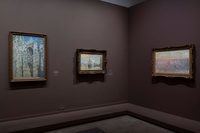
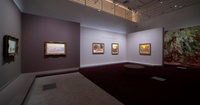
The final section of the exhibition makes the argument that Claude’s use of color, particularly in his late work, was inspired by his brother’s experiments with color and that he could have used synthetic aniline colors that were invented or provided by Leon himself. Such aniline colors allowed a particular diversity of blues, violets, mauves, and reds, for example those derived from alizarin, such as alizarin crimson. This is an intriguing thesis, but one which, as Lefebvre herself notes in the exhibition, cannot be proven. The display includes three late paintings from Giverny (fig. 13) that highlight Monet’s late intense color and flirtations with abstraction. There is also one of Monet’s palettes on view. Monet spoke relatively little in his correspondence about his use of color but, like the other impressionists, he was largely using synthetic, rather than natural, pigments, in these late years. He used a range of paint suppliers, including Troisgros, Latouche, and Carpentier. Ongoing technical analysis of Monet’s late works, as was conducted for example for the Art Institute of Chicago’s online catalogue, is helping us to understand Monet’s palette more precisely, and further analysis will certainly assist in establishing whether there is any potential direct connection with Léon’s colors.[11]
The exhibition is accompanied by a valuable catalogue in French. Unfortunately, there is no English edition. It is edited by Lefebvre and includes a great deal of new research. Lefebvre provides three essays: a biographical discussion of Léon, an examination of his collecting, and a discussion of Claude’s time at Petites-Dalles with Léon. Georges Roque discusses the synthetic pigments used by the impressionists, while Jeanne-Marie David examines Claude’s visits to Léon at Rouen. Frances Fowle provides an excellent essay on Léon’s role in the auction sale organized by the impressionists in 1875. Fowle’s essay nuances some of the information in Merete Bodelsen’s often cited article on this auction, and offers a convincing argument for Léon’s central involvement in the auction, not only as a buyer, but as a close collaborator with his brother in buying paintings and in promoting Claude’s prices.[12] Finally, there are chapters by Geneviève Aitken on the Japanese crepons that Léon also collected, and by Lefebvre and Marianne Mathieu on Léon Monet and his descendants.
A question that arises from this exhibition is the degree of importance of Léon Monet in Claude’s economic career, and it would have been helpful to have seen Léon contextualized a little more in relation to Claude’s other collectors. The exhibition argues for his centrality in Claude’s collecting history, but what we know about his acquisitions, in financial terms, is relatively modest. Certainly, Léon seems to have supported Claude significantly in the 1860s, and many of his paintings date from this period, but, unfortunately, we do not have acquisition information for them. Monet’s account book begins in 1872 and only references three paintings as acquired by Léon for a total of 630 francs (209).[13] In addition, Léon acquired three paintings for 635 francs at the 1875 auction sale, although Navires en réparation (Boats in a Harbor) (see fig. 6) seems to have been bought in for his brother (90–92).[14] Fowle suggests that he may have acquired additional works in collaboration with Claude. In 1875, 1877, and 1878, Léon provided financial support for Claude with advances of 400 francs, 550 francs, and 150 francs, respectively (101). These amounts are relatively low when compared with the support of his principal dealer, Paul Durand-Ruel (who spent 9,800 francs on his paintings in 1872 and 20,100 francs in 1873), or with the purchases of other collectors of the 1870s such as Jean-Baptiste Faure or Ernest Hoschedé.[15] During the 1880s, Léon’s purchases became more infrequent, although he did continue to acquire significant paintings such as the Villas at Bordighera.
Overall, Géraldine Lefebvre’s exhibition is an extremely valuable one and filled with fascinating and new information. It is the product of extensive archival research over some years and offers a focused study of a single collector and, perhaps more importantly, a brother, who was Claude’s only sibling. The relationship between the two men moved from an initial closeness to an eventual falling out. Likewise, the trajectory of their association was founded on their time together in particular locations: Paris, Le Havre, Rouen, Petites-Dalles, and Rouen again. The accompanying catalogue is an important contribution to impressionist studies. Future years may see further discoveries such as perhaps the emergence of correspondence between Léon and Claude. This exhibition succeeds in recuperating Léon Monet’s role as a significant figure within Monet’s network of artists and patrons, as well as within the impressionist network in general.
Notes
[1] Léon Monet is not referenced, for example, in Anne Distel’s important book on impressionist collectors. Anne Distel, Impressionism: The First Collectors (New York: Harry N. Abrams, 1990).
[2] Géraldine Lefebvre, “Cercles et collections impressionistes à Rouen: Léon Monet et François Depeaux,” in François Depeaux: Collectionneur des impressionistes, eds. Sylvain Amic and Joanne Snrech (Paris: In Fine and Musée des Beaux-Arts de Rouen, 2020), 48–61.
[3] Ségolène Le Men and Félicie Faizand de Maupeou, Collectionner l’Impressionisme. Le rôle des collectionneurs dans la constitution et la diffusion du movement (Milan: Silvana Editoriale, 2022).
[4] This detail, from the top right of the painting, has actually been inverted.
[5] Examples of these caricatures, made when Claude was in his teens, are included in the show.
[6] As the exhibition label indicates, the Sisley was acquired by Paul Durand-Ruel at the 1875 impressionist auction and was thus not part of Léon Monet’s collection.
[7] Villas at Bordighera received the highest valuation (8,000 francs) of any work in Léon’s collection in a posthumous inventory. Marine View at Sunset was originally entitled Sunset on the Seine (Coucher de soleil sur la Seine).
[8] “Un petit pavillon toujours clos, où se fabriquaient en secret les couleurs, exhalait une odeur bizarre . . . ” André Gide, Si le grain ne meurt (Paris: Gallimard, 1972, first published 1924).
[9] Other works from this trip, where Monet unusually represented industrial subjects such as the The Stream of Robec (1872) and The Goods Train (1872) are discussed in the catalogue. See Jeanne-Marie David, “Peindre à Rouen: Claude Monet chez son frère Léon,” in Lefebvre, Léon Monet, 58.
[10] The exhibition indeed includes Léon’s whimsical drawing of Claude painting outdoors on the beach in a letter to Camille Pissarro.
[11] See Gloria Groom and Jill Shaw, eds., Monet Paintings and Drawings at the Art Institute of Chicago (Chicago: Art Institute of Chicago, 2014), https://www.artic.edu/. For earlier analysis, see David Bomford, Jo Kirby, John Leighton, and Ashok Roy, eds. Art in the Making: Impressionism (New Haven: Yale University Press, 1991).
[12] See Merete Bodelsen, “Early Impressionist Sales 1874–94 in the Light of Some Unpublished ‘Procès-Verbaux,’” Burlington Magazine 110, no. 783 (1968): 330–49.
[13] The three unidentified paintings are: Canal à Zaandam (1871) purchased in 1872 for 200 francs; Argenteuil (ca. 1874) purchased in 1879 for 200 francs; and Vue de Paris (ca. 1874) purchased in 1875 for 230 francs.
[14] Léon bought Coucher de soleil sur la Seine (Marine View with a Sunset) (ca. 1875), lot 1 in the auction, for 255 francs; the unidentified Landscape (Paysage), lot 6, for 190 francs; and the Navires en réparation, lot 17, for 190 francs.
[15] Simon Kelly, “How Monet became a millionaire: the importance of the artist’s account books,” Journal of Cultural Economics 47, no. 3 (2023): 437–60, https://doi.org/10.1007/s10824-023-09473-y.